Downloads
Before downloading the files, please note that they may be freely used but not for sale or for use in conjunction with commercial or promotional purposes, and provided any use shall be subject to appropriate reference and acknowledgement of the source.
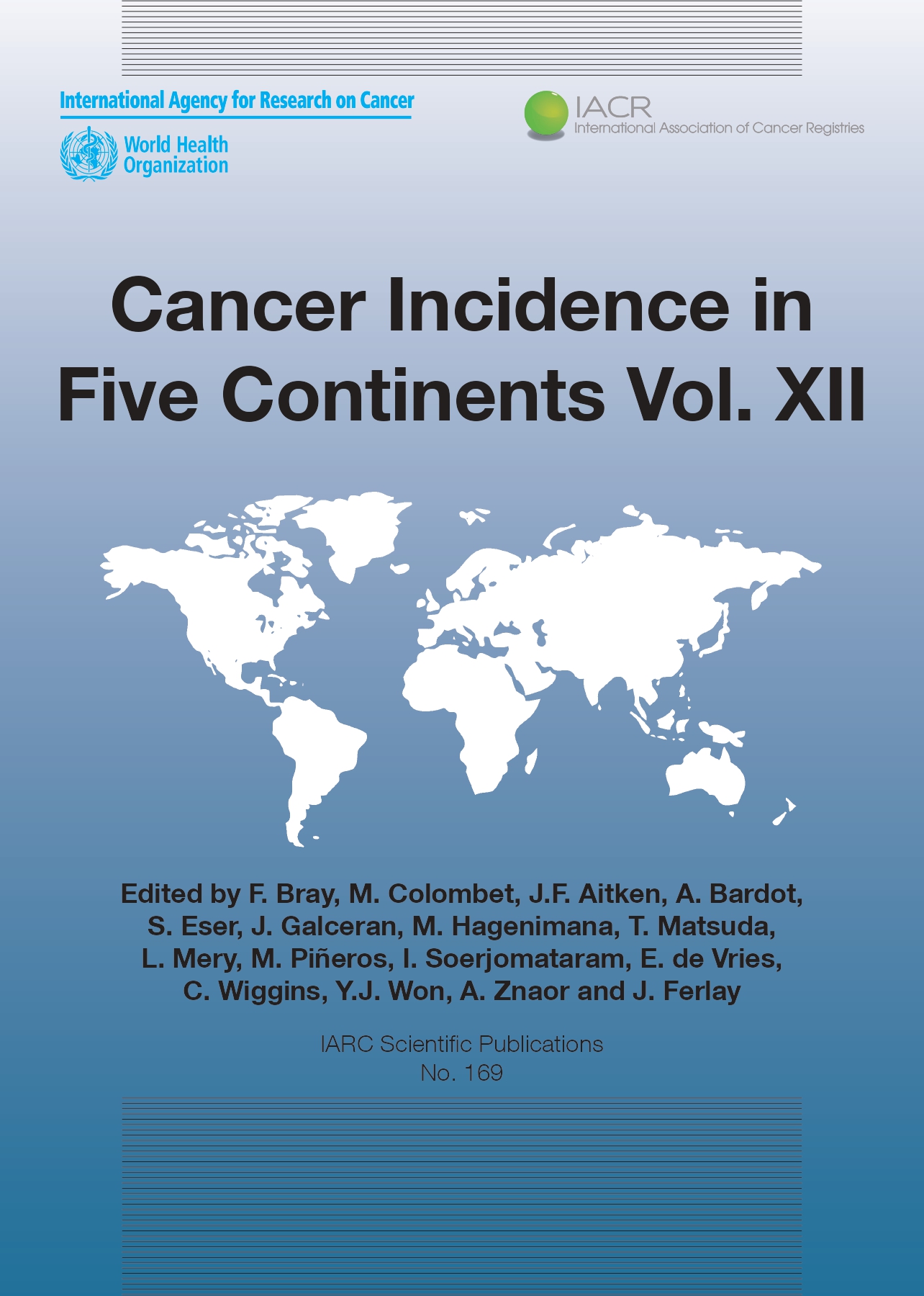
Volume XII
- The printed volume in PDF format.
- The CI5-XII summary database contains the data used in the online analysis options of this Internet application (three-character ICD-10 sites).
- The CI5-XII detailed database contains the data used to produce the book. The standard three-character ICD-10 anatomical sites have been replaced by a set of 345 categories based on a combination of ICD-10 three-or four-character site codes and ICD-O-3 morphological groups (see Table by histological type menu option).
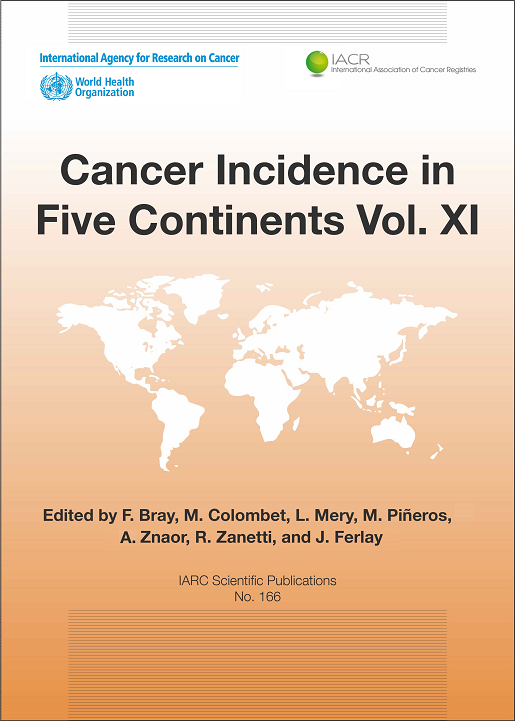
Volume XI
- The printed volume in PDF format.
- The CI5-XI summary database contains the data used in the online analysis options of this Internet application (three-character ICD-10 sites).
- The CI5-XI detailed database contains the data used to produce the book. The standard three-character ICD-10 anatomical sites have been replaced by a set of 241 categories based on a combination of ICD-10 three-or four-character site codes and ICD-O-3 morphological groups (see Table by histological type menu option).
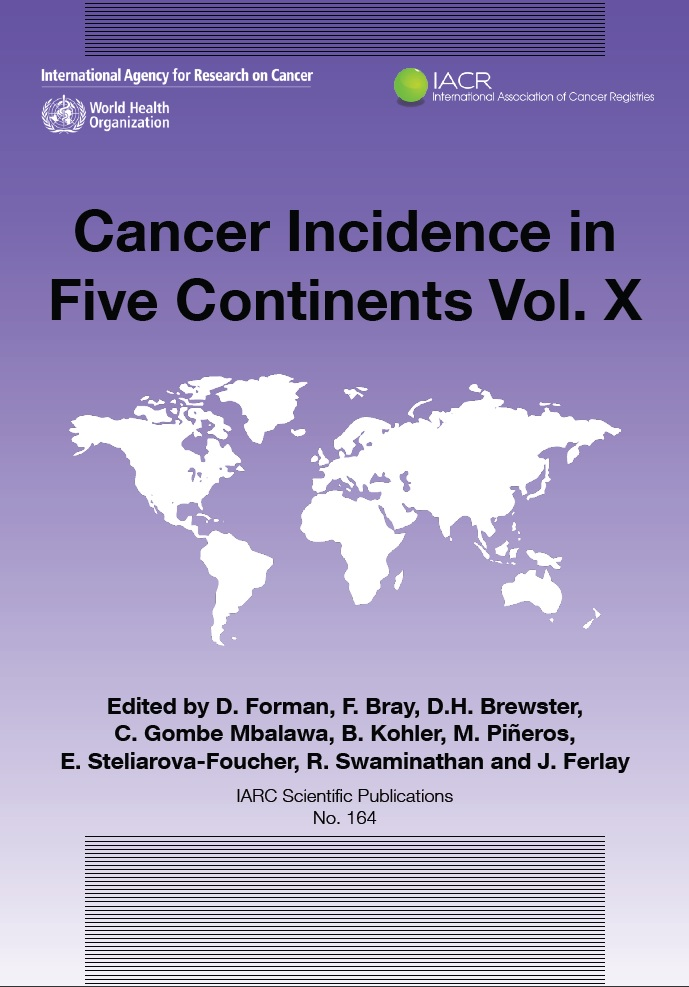
Volume X
- The printed volume in PDF format.
- The tabulated detailed data . The standard three-character ICD-10 anatomical sites have been replaced by a set of 244 categories based on a combination of ICD-10 three-or four-character site codes and ICD-O-3 morphological groups (see chapter 4 of volume X). The data are stored in the traditional form of number of cases by sex, five-year age group and cancer. They are recorded in Comma Separated Value (CSV) format and can be easily incorporated into statistical packages for further analysis. The layout of the data files together with the cancer and the population dictionaries are provided as text files

Volume IX
- The printed volume in PDF format.
- The age-specific tables that appeared in printed form in previous volumes of Cancer Incidence in Five Continents, in PDF format.
- The summary tables, 4-digit rubrics that appeared in printed form in previous volumes of Cancer Incidence in Five Continents, in PDF format.
- The tabulated detailed data used to produce the book. The standard three-character ICD-10 anatomical sites have been replaced by a set of 244 categories based on a combination of ICD-10 three-or four-character site codes and ICD-O-3 morphological groups (see chapter 4). The data are stored in the traditional form of number of cases by sex, five-year age group and cancer. They are recorded in Comma Separated Value (CSV) format and can be easily incorporated into statistical packages for further analysis. The layout of the data files together with the cancer and the population dictionaries are provided as text files.
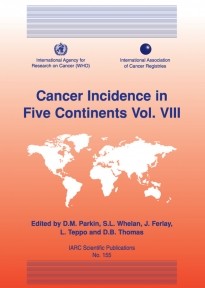
Volume VIII
- The printed volume in PDF format.
- The age-specific tables that appeared in printed form in previous volumes of Cancer Incidence in Five Continents, in PDF format.
- The tabulated detailed data used to produce the book. The standard three-character ICD-10 anatomical sites have been replaced by a set of 252 categories based on a combination of ICD-10 three-or four-character site codes and ICD-O-2 morphological groups (see chapter 7 pages 83-85). The data are stored in the traditional form of number of cases by sex, five-year age group and cancer. They are recorded in Comma Separated Value (CSV) format and can be easily incorporated into statistical packages for further analysis. The layout of the data files together with the cancer and the population dictionaries are provided as text files.
- The CI5 VIII Windows based software to examine the data (included within the package) with more flexibility and in greater detail than in the printed tables.
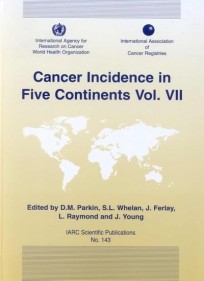
Volume VII
- The printed volume.
- The tabulated detailed data used to produce the book, with the data converted into ICD-10. The standard three-character ICD-10 anatomical sites have been replaced by a set of 252 categories based on a combination of ICD-10 three-or four-character site codes and ICD-O-2 morphological groups(see CI5 Vol. VIII chapter 7 pages 83-85). The data are stored in the traditional form of number of cases by sex, five-year age group and cancer. They are recorded in Comma Separated Value (CSV) format and can be easily incorporated into statistical packages for further analysis. The layout of the data files together with the cancer and the population dictionaries are provided as text files.
- The CI5 VII Windows based software to examine the data (included within the package) with more flexibility and in greater detail than in the printed tables.

Volume VI
- The printed volume.
- The tabulated data used to produce the book. The data are stored in the traditional form of number of cases by sex, five-year age group and cancer (basic ICD-9 list). They are recorded in Comma Separated Value (CSV) format and can be easily incorporated into statistical packages for further analysis. The layout of the data files together with the cancer and the population dictionaries are provided as text files.

Volume V
- The printed volume.
- The tabulated data used to produce the book. The data are stored in the traditional form of number of cases by sex, five-year age group and cancer (basic ICD-9 list). They are recorded in Comma Separated Value (CSV) format and can be easily incorporated into statistical packages for further analysis. The layout of the data files together with the cancer and the population dictionaries are provided as text files.

Volume IV
- The printed volume.
- The tabulated data used to produce the book. The data are stored in the traditional form of number of cases/population by sex, five-year age group and 59 cancers (basic ICD-9 list) for incidence. They are recorded in Comma Separated Value (CSV) format and can be easily incorporated into statistical packages for further analysis.
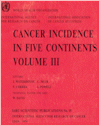
Volume III
- The printed volume.
- The tabulated data used to produce the book. The data are stored in the traditional form of number of cases/population by sex, five-year age group and 59 cancers (basic ICD-9 list) for incidence. They are recorded in Comma Separated Value (CSV) format and can be easily incorporated into statistical packages for further analysis.
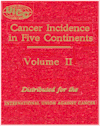
Volume II
- The printed volume.
- The tabulated data used to produce the book. The data are stored in the traditional form of number of cases/population by sex, five-year age group and 59 cancers (basic ICD-9 list) for incidence. They are recorded in Comma Separated Value (CSV) format and can be easily incorporated into statistical packages for further analysis.
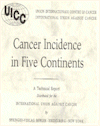
Volume I
- The printed volume.
- The tabulated data used to produce the book. The data are stored in the traditional form of number of cases/population by sex, five-year age group and 59 cancers (basic ICD-9 list) for incidence. They are recorded in Comma Separated Value (CSV) format and can be easily incorporated into statistical packages for further analysis.
Caution
Great care should be exercised when using the detailed databases of Vol. VII, VIII, IX and X, and when comparing incidence rates for histological subtypes of cancers.
The values for the specified histological types will be greatly influenced by the proportion of unspecified cases at a given site. One must also consider the proportion of cases with no microscopic verification, since the calculations of rates for histological subtype can only be done for microscopically verified cases.
Researchers are strongly recommended either to select datasets with few cases in the missing categories, or to make an appropriate adjustment before comparing rates.

